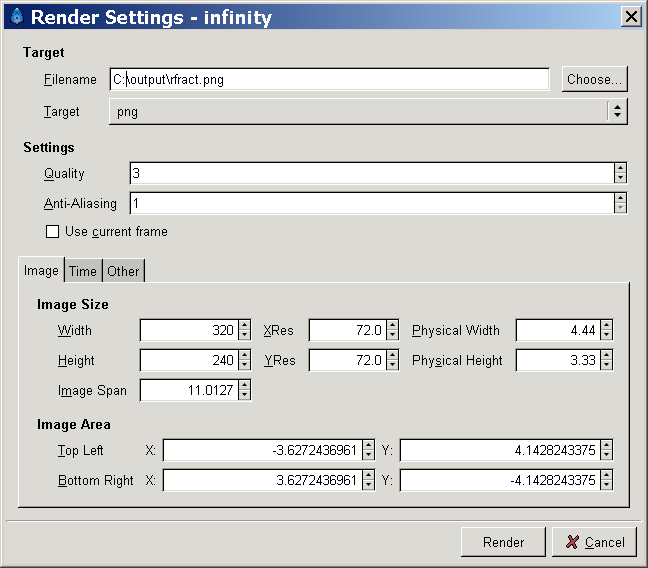Render options
Here are the file types that can be rendered
- gif - graphic interchange format
- imagemagick - image manipulation program
- jpeg - Joint Photographic Expert Group - still format suited to photographs
- null - Dummy file for rendering engine testing?
- null-tile - Dummy file for rendering engine testing?
- open-exr - Still image designed for handling Motion picture frames developed by ILM
- png - portable Network graphics - still images with lossless compression
- ppm - portable pixmap - still image using very basic format - synfig appears to render this target as a png
- yuv420p - Still image format designed to preserve the images luminance
| Target type | Extension | Helper app | Linux support | Windows support |
|---|---|---|---|---|
| Auto | (.bmp -> bmp) (.dv -> dv_trgt) (.mpg -> ffmpeg_trgt) (.gif -> gif) (.miff -> imagemagick_trgt) (.jpg -> jpeg_trgt) (.avi -> Target_LibAVCodec) (.mng -> mng_trgt) (.exr -> exr_trgt) (.png -> png_trgt) (.ppm -> ppm) (.yuv -> yuv) | Determined by extension (if you're lucky!) | png -> png OK, , gif -> bmp (bad), miff -> bmp, exr ->bmp, dv -> bmp and bad rendered, gif -> bmp (the bmp is ok), yuv ->bmp, ppm -> ppm OK, | Seems to generate a bmp (or series of bmps) regardless of extension. |
| bmp | bmp | Native | ? | Yes |
| dv | dv | encodedv | ? | untested |
| ffmpeg | mpg | ffmpeg | ? | Error - could not find codec parameters (video: ppm, gray) |
| gif | gif | native | ? | yes (animated gifs also) |
| imagemagick | miff | imagemagick | ? | Renders to a readable file, but the image is corrupted |
| jpeg | jpg | native | ? | yes |
| null | n/a | n/a | n/a | n/a |
| null-tile | n/a | n/a | n/a | n/a |
| open-exr | exr | native | ? | yes |
| png | png | native | ? | yes |
| ppm | ppm | native | ? | yes |
| yuv420 | yuv | native | ? | yes |
Rendering to Video
Rendering to video directly from Synfig under Windows presents some challenges.
Due to current limitations, you'll want to save a series of images that represent your animation, to a still format that ffmpeg can read. I recommend png. Whilst you can render to any size image, if you're going to show your video on Youtube, you may want to take that into account when you render.
If you set up your render like 
Image size - width 320 Xres 72.0 Phys width 4.44 Height 240 Yres 72.0 Phys Height 3.33 (Image span 11.0127
Image area Top left X: -3.67 Y:4.2 Bottom right X: 3.67 y:-4.2)
You will get a series of png files in your output directory. Open a command prompt, cd to that directory, then use ffmpeg to assemble these png files into the video stream of your choice. for example -
C:\output>ffmpeg -r 15 -i rfrac%04d.png -f flv fractal.flv
creates a Flash video file of with the same framerate as used on Youtube. You should be able to submit it to Youtube without the need for the Youtube servers to have to re-compress it.
